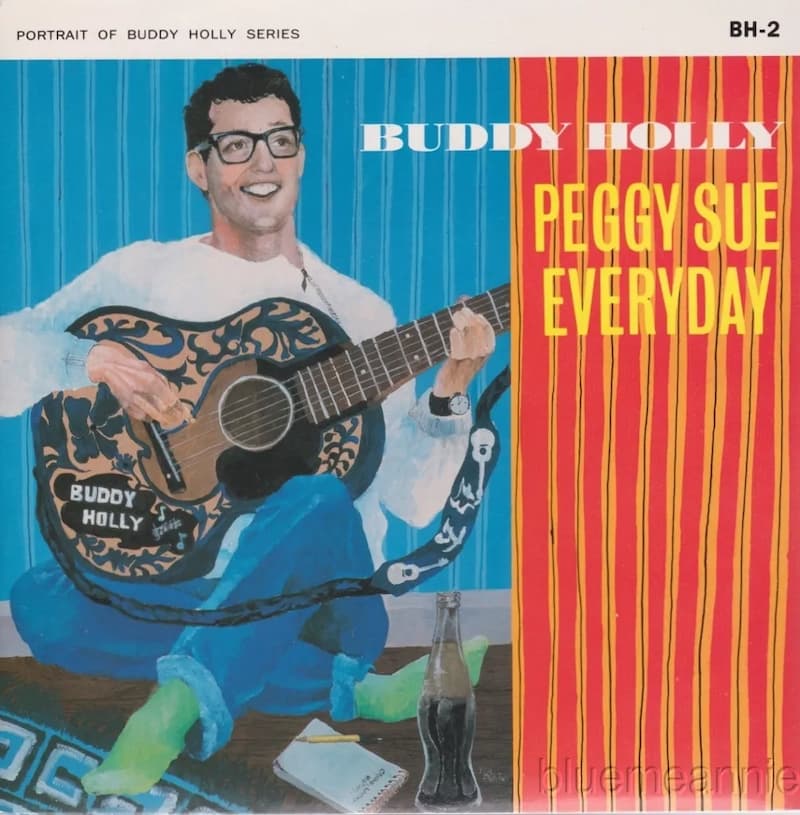
In the storied year of 1957, after achieving chart-topping success in both America and the UK with the immortal hit “That’ll Be the Day,” Buddy Holly and the Crickets turned their creative talents to a gentler project. Originally, the band wrote a tender tune called “Cindy Lou” as a loving tribute to Holly’s young niece, Cindy Lou, who was the daughter of Holly’s sister Pat.
However, destiny took a poignant turn during a rehearsal session when drummer Jerry Allison stormed in, visibly upset. His girlfriend, Peggy Sue Gerron, had just ended their relationship. Moved by his turmoil, the band swiftly transformed the lyrics of “Cindy Lou,” crafting a fresh plea—now called “Peggy Sue”—aimed at winning back Allison’s love.
The song burst forward with a galloping, energetic beat, accentuated by Jerry Allison’s pounding tom-toms, delivering a raw and heartfelt declaration:
If you knew Peggy Sue, then you’d know why I feel blue,” sung Holly, pouring emotion before passionately proclaiming, “Well, I love you girl, and I need you, Peggy Sue!
The music was simple but irresistible, a direct message packed with emotion.
They performed “Peggy Sue” at a California concert where Peggy Sue herself was in the audience. Yet, instead of softening her heart, the surprise performance left her feeling deeply embarrassed. “I was so embarrassed I could have died!” she later confessed in her autobiography, Whatever Happened to Peggy Sue? Despite her discomfort, the song soared, cracking the Top 10 charts in both the US and UK that same year, emerging as one of the most electrifying rock ’n’ roll renditions of all time.
In a twist worthy of a romantic ballad itself, Peggy Sue and Jerry Allison reconciled and married in 1958. Buddy Holly celebrated their union in a heartfelt sequel, “Peggy Sue Got Married”, recorded alone with his guitar in a New York apartment that December. Tragically, Buddy’s life was cut short just two months later in the infamous 1959 plane crash that claimed not only his life but those of Richie Valens and the Big Bopper—an event immortalized as “The Day the Music Died.” Holly’s recording of “Peggy Sue Got Married” surfaced posthumously, resonating as a poignant echo of the original.
Though the sequel remains a minor footnote in pop history and even inspired the title of a 1986 Kathleen Turner comedy, the original “Peggy Sue” has etched itself firmly into the annals of rock history. Notably, it helped launch the career of 15-year-old Bobby Vee, who filled in for Holly at a Minnesota show on the very day the crash occurred. Vee’s version alongside The Crickets on the 1962 album Bobby Vee Meets the Crickets paid homage to Holly’s legacy.
Across the Atlantic, the legendary Cliff Richard and the Shadows idolized Buddy Holly so deeply that “Peggy Sue” routinely featured in their live sets. Guitarist Hank Marvin’s iconic big glasses were a tribute to Holly’s style. The emotional power of Holly’s music transcended even years after his demise; during their 1960 US tour, Holly’s widow, Maria, was moved to tears by Marvin’s uncanny stage resemblance to her late husband.
The story of “Peggy Sue” reveals not just a rock and roll anthem but a deeply personal narrative of love, loss, and legacy that continues to echo through generations. From a simple favor for a niece to a chart-topping plea of devotion, and ultimately a symbol of a vibrant era cut tragically short, “Peggy Sue” captures the timeless passion of Buddy Holly and the Crickets.